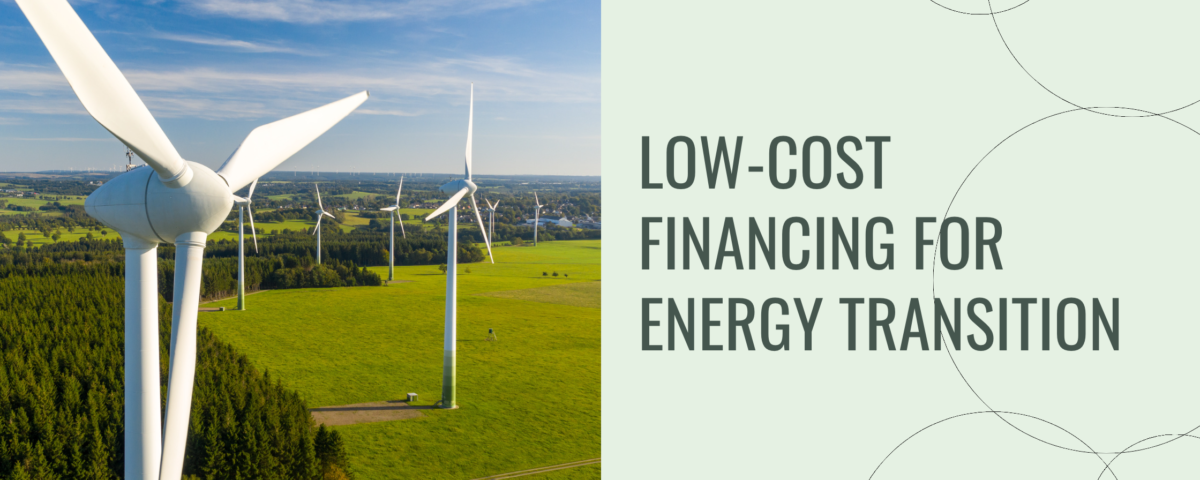
Strategies for implementing low-cost finance for energy transition in India
June 12, 2023In the dynamic landscape of India, the energy transition assumes a pivotal role as the country strives for sustainability and endeavors to reduce greenhouse gas emissions. The multifaceted transformation of India’s energy sector aims to pave the way for a future characterized by environmental responsibility and carbon neutrality. This objective aligns with India’s commitment to the Paris Agreement on climate change, which aims to limit global warming to well below 2 degrees Celsius above pre-industrial levels.
India faces unique challenges in its pursuit of a net-zero future due to its rapidly growing population, increasing energy demands, and reliance on fossil fuels. However, the country has demonstrated its determination to address these challenges and transition towards cleaner energy alternatives.
The energy transition refers to the shift from reliance on fossil fuels to the utilization of renewable and clean energy sources, with the ultimate goal of achieving a net-zero future. Shifting from fossil fuel-based energy systems to clean and renewable sources is vital for combating climate change and curbing greenhouse gas emissions.
To achieve a net-zero future, primarily India aims to:
Increase Renewable Energy Capacity
One of the key strategies employed by India in its pursuit of a net-zero future is to significantly increase its capacity for renewable energy generation, including solar, wind, hydro, biomass, and offshore wind. Recognizing the immense potential of these renewable sources, India has set a goal of achieving 450 gigawatts of renewable energy capacity by 2030.
This target is a substantial leap from the current capacity and requires a concerted effort in scaling up renewable energy infrastructure. To achieve this goal, the Indian government has implemented various policy measures and incentives to attract investments in the renewable energy sector. These include financial incentives, tax benefits, and simplified regulatory processes to encourage both domestic and foreign investments.
By increasing its renewable energy capacity, India aims to reduce its reliance on fossil fuels, lower greenhouse gas emissions, and create a sustainable and resilient energy sector. This ambitious endeavor not only drives economic growth and job creation but also positions India as a global leader in renewable energy deployment.
Enhance Energy Efficiency
Energy efficiency plays a crucial role in reducing carbon emissions. India is focusing on improving energy efficiency in various sectors, including buildings, transportation, and industries. Initiatives such as National Mission for Enhanced Energy Efficiency (NMEEE), Energy Conservation Building Code, fuel efficiency standards, and energy-efficient appliances are being implemented.
National Mission for Enhanced Energy Efficiency (NMEEE) is one of the eight missions under the National Action Plan on Climate Change (NAPCC). Perform, Achieve and Trade (PAT) is the flagship programme under the mission implemented by Bureau of Energy Efficiency (BEE) under the aegis of Ministry of Power. PAT scheme aims at reducing Specific Energy Consumption (SEC) i.e. energy use per unit of production for Designated Consumers (DCs) in energy intensive sectors, with an associated market mechanism to enhance the cost effectiveness through certification of excess energy saving which can be traded. The excess energy savings are converted into tradable instruments called Energy Saving Certificates (ESCerts) that are traded at the Power Exchanges. The two Power Exchanges such as India Energy Exchange (IEX) and Power Exchange India Limited (PXIL) provide the trading platform where the Designated Consumers (DCs) who fall short of their compliance, bid for purchase of ESCerts. PAT Scheme is implemented in cycles of 3 years each where the Designated Consumers (DCs) are assigned SEC reduction targets.
Electrification and Clean Transportation
Electrification and clean transportation are gaining momentum in India as the country strives for a sustainable future. With a focus on reducing emissions from the transportation sector, India is actively promoting the adoption of electric vehicles (EVs). Initiatives such as the Faster Adoption and Manufacturing of Electric Vehicles (FAME) scheme provide incentives and support for EV adoption.
Efforts are also underway to develop a robust charging infrastructure network, making it easier for EV owners to recharge their vehicles. Public transportation electrification, including the introduction of electric buses, is being prioritized, while last-mile connectivity is being improved with the use of electric rickshaws and two-wheelers.
Integration of renewable energy into charging infrastructure and favorable policy frameworks further drive the shift towards electrification and clean transportation in India, fostering a greener and more sustainable transportation system for the nation.
India is promoting the adoption of electric vehicles (EVs) and investing in the development of charging infrastructure. The aim is to reduce dependence on fossil fuel-powered vehicles and transition towards cleaner and more sustainable transportation systems.
As we strive for a net-zero future, we encounter challenges that can impede the progress of the energy transition. One of the significant hurdles is the presence of cost barriers and financing limitations. The upfront expenses associated with renewable energy adoption and clean technologies can pose financial burdens, restricting their widespread implementation. Insufficient access to low-cost financing options further exacerbates these challenges, hindering the pace and scale of the transition. Overcoming these barriers is crucial for accelerating the shift towards a sustainable and decarbonized energy system.
Here are some key challenges associated with the transition:
High Initial Costs
In India, one of the major challenges in the energy transition is the high initial cost of renewable energy projects. While renewable energy sources such as solar and wind power offer long-term benefits, their installation and setup costs can be significant. The upfront investment required for infrastructure development, equipment procurement, and technology installation pose financial barriers for individuals, businesses, and governments. This high initial cost can deter potential investors and limit the widespread adoption of renewable energy in the country.
However, it’s important to note that as technology advances and economies of scale are realized, the costs of renewable energy are gradually decreasing, making it a more financially viable option in the long run. Additionally, government incentives, subsidies, and favorable policies are being implemented to offset the high initial costs and encourage the transition to renewable energy sources.
Limited Access to Affordable Finance
In India, financing limitations pose a significant challenge to the energy transition. Limited availability of affordable financing options for clean energy projects can hinder their implementation and expansion.
Financial institutions often perceive renewable energy projects as high-risk investments, leading to higher interest rates and stringent lending criteria. This restricts the access of developers, businesses, and individuals to the necessary capital for transitioning to renewable energy. Additionally, the lack of awareness and understanding among financial institutions about the renewable energy sector further contributes to financing limitations.
To address this, there is a need for innovative financing mechanisms, such as green banks, dedicated funds, and risk mitigation instruments, to attract low-cost finance and reduce perceived risks associated with renewable energy investments. Moreover, collaboration between the government, financial institutions, and international organizations can help unlock additional sources of financing and promote the energy transition in India.
Technology Costs and Scalability
Technology costs and scalability are key challenges that need to be addressed in the energy transition. While renewable energy technologies have made significant advancements, they still face cost barriers that can hinder their widespread adoption. The initial costs of implementing renewable energy solutions, such as solar panels or wind turbines, can be higher compared to traditional fossil fuel-based systems. These upfront expenses can deter potential investors and limit the pace of the transition.
Scalability is another crucial factor to consider. Some renewable energy technologies, such as solar and wind power, have experienced significant growth and are becoming more scalable. However, certain technologies, such as advanced energy storage systems or emerging clean energy solutions, may still face scalability challenges. The availability of adequate manufacturing capabilities, supply chains, and infrastructure can impact the scalability of these technologies.
Addressing these challenges requires concerted efforts in research and development, innovation, and market expansion. Continued advancements in technology can lead to cost reductions, improved efficiency, and increased scalability. Government support through incentives, subsidies, and policies that promote research and deployment of renewable energy technologies can also drive down costs and facilitate scalability. Collaboration between industry stakeholders, policymakers, and research institutions is essential to overcome technology costs and scalability barriers and accelerate the energy transition towards a net-zero future.
Regulatory and Policy Uncertainty
Regulatory and policy uncertainty poses a significant challenge to the energy transition. Inconsistent or unpredictable regulations and policies can create barriers for businesses and investors in the renewable energy sector, hindering their ability to plan and invest in clean energy projects. To address this, governments should establish clear, stable, and long-term frameworks that support the energy transition. Transparent regulations, supportive policies, stakeholder engagement, and international collaboration can help reduce uncertainty, attract investments, and accelerate the transition to a low-carbon and sustainable energy future.
Limited Awareness and Capacity
Limited awareness and capacity present significant challenges to the energy transition. Many individuals, communities, and businesses may have limited knowledge about the benefits and potential of renewable energy and energy efficiency measures. This lack of awareness can result in a reluctance to adopt clean energy technologies and practices.
Furthermore, there may be a lack of capacity and expertise in implementing and managing renewable energy projects. The technical knowledge and skills required for designing, installing, and maintaining renewable energy systems may be limited among professionals and workers in the energy sector.
Addressing these challenges requires concerted efforts from multiple stakeholders, including governments, financial institutions, businesses, and communities. To overcome cost barriers and financing limitations, it is crucial to develop innovative financing mechanisms, establish supportive policies, provide incentives for renewable energy investments, and strengthen public-private partnerships. Collaboration and knowledge-sharing among countries can also play a significant role in addressing these challenges and accelerating the energy transition to a net-zero future.
By limiting global warming, we can prevent severe consequences like rising sea levels, extreme weather events, and disruptions to ecosystems. Additionally, the energy transition brings forth various benefits such as improved air quality, reduced dependence on finite fossil fuel resources, enhanced energy security, and the creation of new employment opportunities. Embracing this transition is essential for building a sustainable, resilient, and inclusive future for generations to come.

